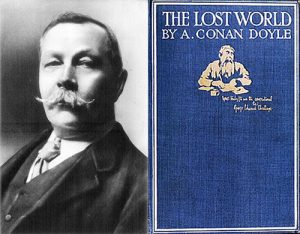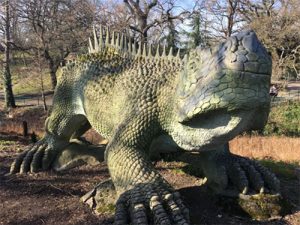Do you remember the famous Steven Spielberg’s thrillers of the 1990s – Jurassic Park and The Lost World? Do you know who was the first to think of dinosaurs being alive? This was over 100 years before Michael Crighton’s Jurassic book, which became the basis for the film.
This idea first appeared in Jules Verne’s book (Journey to the Centre of the Earth) in 1864. Dinosaurs there lived deep down underground.
A few writers around the world developed these ideas further, and one of the famous such novels is The Lost World, published in 1912. It was written by Sir Arthur Conan Doyle of Sherlock Holmes fame. Today not many people know that he also gave us The Lost World – the dream that each adventure seeker may one day meet these prehistoric creatures.
How come that a doctor with a London practice, writing detective fiction in his spare time, came to get interested in dinosaurs?
By the beginning of the 20th century paleonthology was thriving in England. Just under 100 years earlier had been discovered that the South coast of England was the right Prehistoric Park. It even came to be known as Jurassic Coast. The 150 km of coastline between Exmouth and Swanage, where the waters of the English Channel wash the soil off the rocks, there is a treasure trove of finds from the Triassic, Jurassic and Cretaceous periods.
The first finds were made by a Sussex doctor Gideon Mantell in 1822. He first discovered fossilised teeth, followed by parts of an iguanodon skeleton.
There were women among early paleonthologists. Mary Anning, who lived in the seaside town of Lyme Regis, started looking for fossils as a child, and devoted her whole life to studying them. It was hard for her to make her mark on the scientific world. As a woman, and a non-Anglican (she was Protestant), she struggled to be taken seriously by the male colleagues and the public in general. Her finds including ichthyosaur, plesiosaur and pterosaur, are part of the paleonthology collection of the Natural History Museum in Kensington.
The collection was the brainchild of scientist Richard Owen. Initially all fossil finds came to the British Museum. Richard Owen started a campaign to set up a separate institution, devoted to natural history. In 1888 Natural History Museum was opened in a separate specially constructed building next to the Victoria and Albert Museum in Kensington. Owen gave us something else to remember him by – he came up with the word “dinosaur”, based on Greek words meaning Fearfully Great Reptile.
Natural History Museum was not just a collection of artifacts, but a driving force for the development of science. By the beginning of the 20th century, London was the home of
— The Royal Society (founded in 1660) – the British ‘Academy of Science’
— The Royal Geographical Society (founded in 1807)
— Zoological Society of London (founded in 1826)
— The Royal Entomological Society (founded in 1833)
Their envoys travelled the world, bringing back curiosities from all fields of science.
In 1911 Conan Doyle attended a lecture by his friend, archaeologist, explorer and adventurer Percy Harrison Fawcett, who had just returned from Bolivia and was reporting to the meeting of the Geographical Society. Conan Doyle was amazed and inspired, — he asked Fawcett to tell him all he knew about the ‘lost world’.
In 1912 the Strand Magazine started serialising Conan Doyle’s novel with detailed illustrations by the artist Harry Rountree. Later The Lost World was published as a book.
Putting Sherlock Holmes aside, Conan Doyle, or, to be precise, the journalist Edward Malone, who is telling the story, takes us on an perilous journey to the South America. The aim of the trip is to ascertain the truth behind Professor’s Challenger’s supposition that dinosaurs were alive, — or to prove him to be a liar, as believed by the Zoological Society and his main opponent, Professor Summerlee.
The party, which includes the adventurer Lord Roxton, found a plateau in the Jungle, inhabited by pterodactyls, giant snakes and iguanodons, as well as and ape-men and a tribe of ancient people. After many wild and breath-taking adventures they return to London, bringing a proof – a live pterodactyl, smuggled by Professor Challenger. While the Zoological Society marvel at the find, the prehistoric creature makes for the window and disappears …
And here it is, perched on the pediment around the top of the Natural History Museum, creatures, perfectly executed in terracotta.




I tell the full story of Sir Arthur Conan Doyle and The Lost World in my lecture — full details here.


